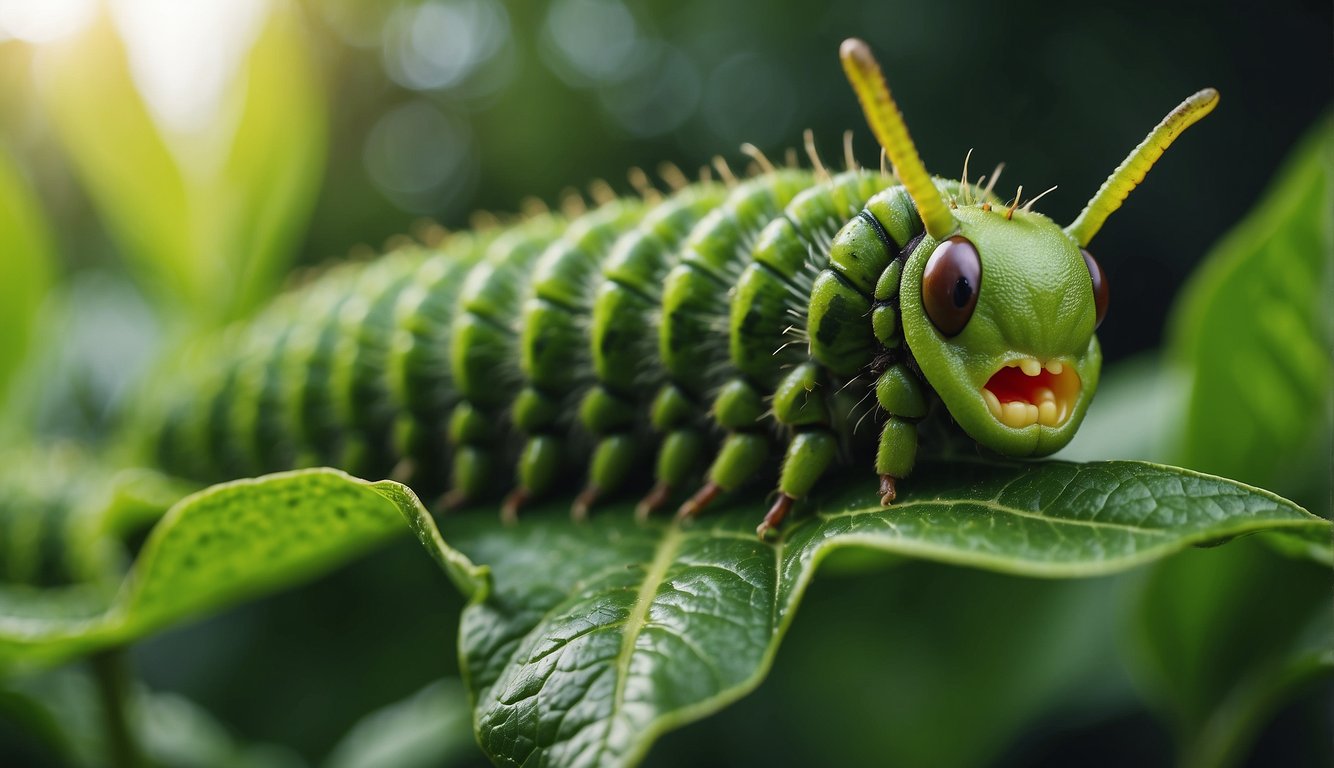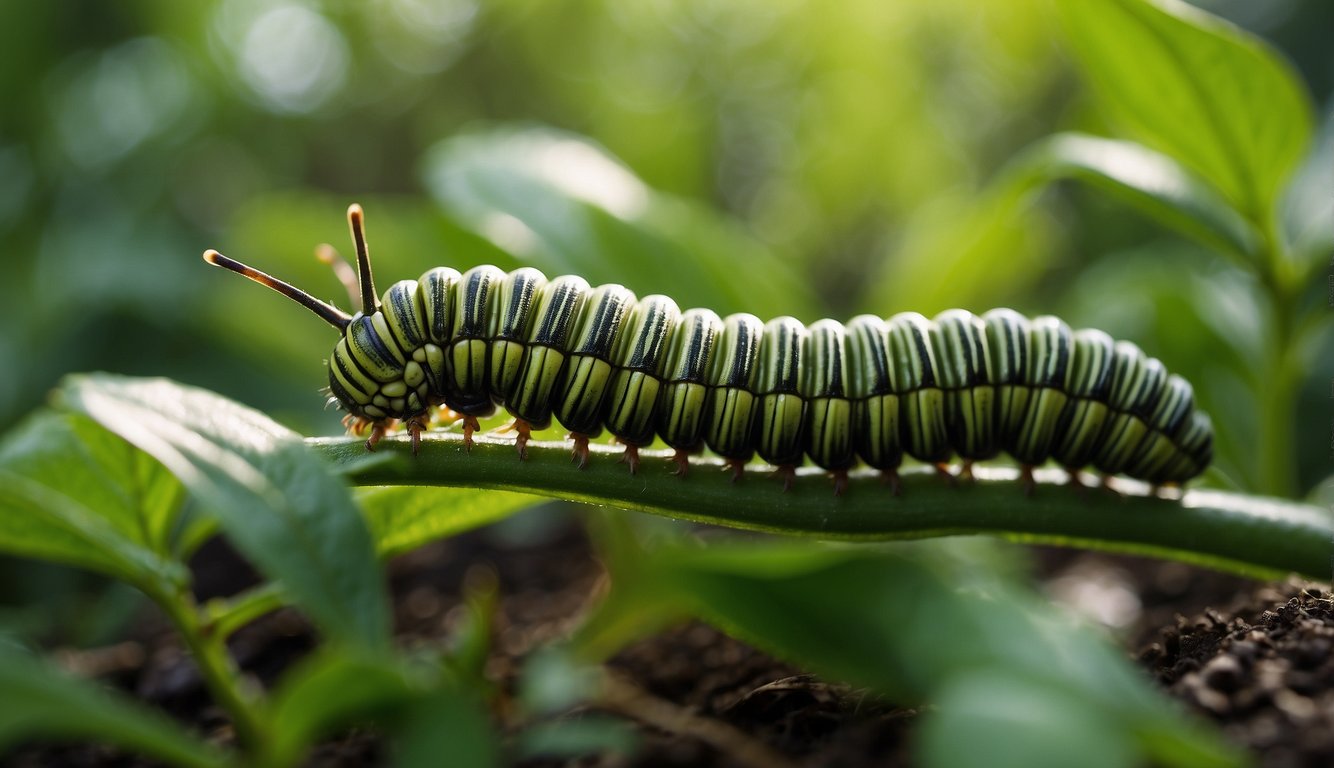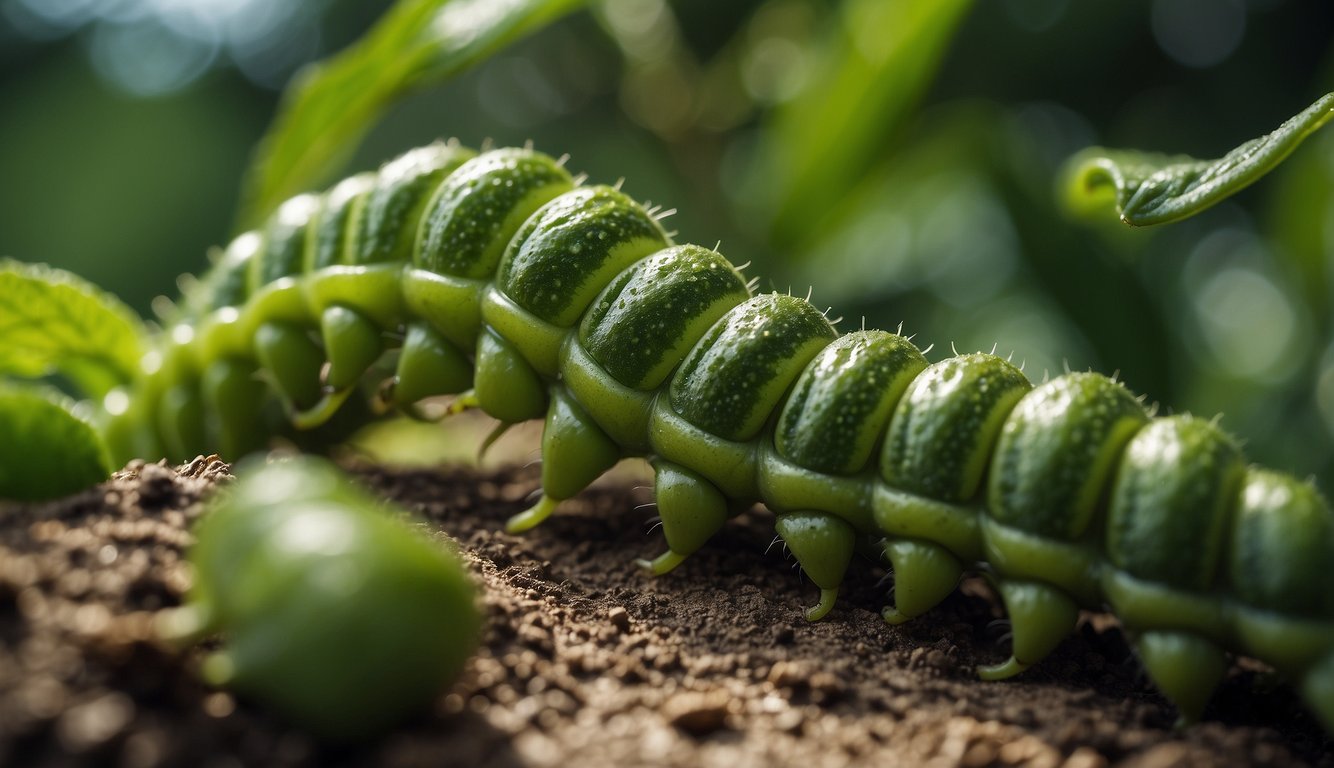TheHerbProf.com is a treasure trove of knowledge for those interested in natural healing and herbal remedies. The website is run by Paul Johnston MD. A naturopathic who has not only received extensive education in the field but also has personal experience in self-healing.
As a gardener, I have come across many pests that can harm my plants, but one that always catches my attention is the big green caterpillar on pepper plant. These caterpillars can cause significant damage to the leaves and fruit of the pepper plant, leaving it vulnerable to other pests and diseases. It is essential to identify and control these pests early on to prevent any significant damage to the plant.
The big green caterpillar on the pepper plant is also known as the tomato hornworm. These caterpillars are usually found on tomato plants, but they can also infest pepper plants. They are large, green caterpillars with white stripes and a horn-like protrusion at the rear end. They can eat voraciously and decimate all the leaves on a plant overnight. Therefore, it is crucial to identify and control them early on before they cause significant damage to your pepper plants.
In this article, I will provide you with information on how to identify and control the big green caterpillar on your pepper plants. I will also provide you with some organic methods to control these pests without using harmful chemicals. By the end of this article, you will have a clear understanding of how to deal with these pests and keep your pepper plants healthy and thriving.
Identifying the Big Green Caterpillar
Physical Characteristics – Big Green Caterpillar on Pepper Plant
The big green caterpillar found on pepper plants is a member of the sphinx moth family. These caterpillars are characterized by their large size, reaching up to 4 inches in length, and their bright green color. They have a distinctive horn-like appendage at the rear, which can be either straight or curved. The body of the caterpillar is covered in small spikes or spines, which can be black or white.
Common Species
The two most common species of big green caterpillars found on pepper plants are the tomato hornworm and the tobacco hornworm. The tomato hornworm has V-shaped white markings on its green body, while the tobacco hornworm has diagonal white stripes. Both species are members of the sphinx moth family and can be found throughout North America.
Habitat and Range – Big Green Caterpillar on Pepper Plant
Big green caterpillars can be found in gardens and fields where their host plants, such as tomato, pepper, and tobacco plants, are grown. They are most commonly found in the United States and Europe.
Life Cycle and Development
The life cycle of the big green caterpillar begins when the female sphinx moth lays her eggs on the leaves of the host plant. The eggs hatch into larvae, which then feed on the leaves of the plant. As they grow, they go through several molts before pupating and eventually emerging as adult moths.
Signs of Infestation
Signs of a big green caterpillar infestation include holes in the leaves of the host plant, defoliation, and the presence of frass or droppings on the leaves. If left untreated, a big green caterpillar infestation can cause significant damage to the host plant.
Impact on Pepper Plants – Big Green Caterpillar on Pepper Plant

Physical Damage
The big green caterpillars on pepper plants can cause significant physical damage to the plant. They feed on the leaves, foliage, flowers, buds, and even the fruit of the pepper plant. As they eat, they create holes in the leaves and can cause significant defoliation, which can stress the plant and affect its growth and yield. In severe cases, the caterpillars can completely defoliate the plant, leaving it vulnerable to other garden pests and diseases.
Plant Health
The presence of big green caterpillars on pepper plants can also affect the overall health of the plant. When the caterpillars feed on the plant, they release an acid that can damage the tissue and make it more susceptible to disease. The damage caused by the caterpillars can also attract other pests, which can further damage the plant.
Growth and Yield
The damage caused by big green caterpillars on pepper plants can also affect the growth and yield of the plant. When the leaves are damaged, the plant cannot photosynthesize effectively, which can lead to stunted growth and reduced yield. Additionally, if the caterpillars feed on the fruit of the plant, it can become misshapen or inedible, which can reduce the overall harvest.
Natural Predators and Ecosystem Role – Big Green Caterpillar on Pepper Plant
While big green caterpillars on pepper plants can be damaging, they also play a role in the ecosystem. They are a food source for beneficial insects such as ladybugs, lacewings, and parasitic wasps, which can help control other garden pests. Additionally, caterpillars that survive to adulthood become fast-flying moths that are important pollinators for many plants.
Overall, while big green caterpillars on pepper plants can cause significant damage, it is important to remember their role in the ecosystem and to use natural methods to control their populations.
Prevention and Control Methods

When it comes to preventing and controlling big green caterpillars on pepper plants, there are several effective methods to consider. These methods can be grouped into four categories: cultural practices, physical barriers, biological control, and chemical solutions.
Cultural Practices – Big Green Caterpillar on Pepper Plant
Cultural practices are an important part of pest management. To prevent big green caterpillars on pepper plants, it is important to maintain a healthy garden environment. This can be achieved by:
- Removing any debris or fallen fruit from the garden
- Rotating crops to prevent soil-borne diseases
- Sanitizing tools and equipment before use
- Providing proper drainage to prevent waterlogging
Physical Barriers
Physical barriers can be used to prevent big green caterpillars from accessing pepper plants. This can be achieved by:
- Using row covers to protect plants from adult moths
- Installing netting or cages around plants to prevent caterpillars from reaching them
Biological Control
Biological control involves using natural predators or parasites to control pests. This method can be effective in controlling big green caterpillars on pepper plants. Some examples of biological control include:
- Introducing beneficial insects such as ladybugs, lacewings, and parasitic wasps to the garden
- Encouraging natural predators such as birds and toads to visit the garden
Chemical Solutions
Chemical solutions should be used as a last resort, as they can harm beneficial insects and pollinators. However, if other methods fail, chemical solutions can be effective in controlling big green caterpillars on pepper plants. Some examples of chemical solutions include:
- Using pesticides that contain Bacillus thuringiensis (Bt), a naturally occurring bacteria that is toxic to caterpillars
- Using soapy water or neem oil to kill caterpillars on contact
By implementing these prevention and control methods, gardeners can effectively manage big green caterpillars on pepper plants and maintain a healthy garden environment.
Environmental Considerations – Big Green Caterpillar on Pepper Plant

Impact on Non-target Species – Big Green Caterpillar on Pepper Plant
As a responsible gardener, it is important to consider the impact of using pesticides on non-target species in the ecosystem. Pesticides not only harm the target pest, but also beneficial insects such as butterflies and bees, which are important pollinators in the garden. In addition, pesticides can also harm garden wildlife such as birds and small mammals that feed on insects.
When dealing with big green caterpillars on pepper plants, it is important to use pesticides that are specific to this pest and will not harm other beneficial insects. Organic and sustainable practices such as integrated pest management (IPM) can be used to control pests while minimizing harm to non-target species.
Sustainable Practices and Organic
Organic gardening and sustainable agriculture practices can help minimize the use of pesticides and their impact on the environment. Some organic methods for controlling big green caterpillars on pepper plants include handpicking the caterpillars off the plant, using insecticidal soap or neem oil, and introducing natural predators such as parasitic wasps.
In addition, planting companion plants such as marigolds or basil can help to repel caterpillars and other pests. These plants release natural compounds that act as a natural pest repellent, reducing the need for pesticides.
Overall, it is important to consider the impact of using pesticides on non-target species in the ecosystem and to use organic and sustainable practices whenever possible to minimize harm to the environment. By using these methods, we can control big green caterpillars on pepper plants while maintaining a healthy and thriving garden.
Additional Resources – Big Green Caterpillar on Pepper Plant

As a gardener, it’s essential to have access to reliable resources that can provide you with expert advice, guidance, and information on how to deal with pests and other problems in your garden. Here are some additional resources that can help you identify and control big green caterpillars on your pepper plants.
Expert Advice and Extension Services – Big Green Caterpillar on Pepper Plant
If you’re looking for expert advice on how to deal with big green caterpillars on your pepper plants, then you can turn to your local agricultural extension service. These services offer a wealth of information and guidance on all aspects of gardening, including pest control. You can also consult with gardening clubs or online forums to get advice from experienced gardeners.
Identification Guides and Tools
If you’re not sure what kind of caterpillar is eating your pepper plants, then you can use identification guides and tools to help you identify the pest. There are several field guides and mobile apps available that can help you identify common garden pests. You can also use online resources to help you identify pests and learn more about their behavior and life cycle.
Having access to reliable resources and information is crucial for any gardener dealing with big green caterpillars on their pepper plants. By consulting with experts, using identification guides and tools, and staying informed, you can effectively control pests and protect your garden.
Before You Go – Big Green Caterpillar on Pepper Plant

Dealing with big green caterpillars on pepper plants can be a daunting task, but with the right pest management techniques, it can be managed effectively. The key to preventing these caterpillars from infesting your pepper plants is to take a few preventative measures. One of the best ways to do this is by setting up a trap crop of hot peppers around your garden. This will attract the caterpillars away from your pepper plants, and you can then dispose of them.
Another effective method of pest management is to handpick the caterpillars off your pepper plants. This is a time-consuming process, but it is an effective way to remove the caterpillars without using harmful pesticides. It is essential to do this regularly to prevent the caterpillars from causing significant damage to your pepper plants.
If you prefer to use pesticides, make sure to choose one that is safe for use on vegetables and follow the instructions carefully. Always wear protective gear when handling pesticides, and keep them out of reach of children and pets.
In addition to pest management, there are also some gardening tips that can help prevent caterpillars from infesting your pepper plants. For example, make sure to plant your pepper plants in well-draining soil and provide them with adequate water and sunlight. This will help keep your plants healthy and less susceptible to pests.
Overall, dealing with big green caterpillars on pepper plants can be challenging, but with the right techniques, it can be managed effectively. By taking preventative measures, practicing good pest management, and following gardening tips, you can keep your pepper plants healthy and free of infestations.
Big Green Caterpillar on Pepper Plant
Let’s delve into the world of big green caterpillars on pepper plants!
Firstly, we have the caterpillar. It’s likely a tomato hornworm. They’re big, green, and love munching on your pepper plants!
Next, let’s talk about beneficial insects. Ladybugs and wasps are natural predators of these caterpillars. Invite them into your garden!
Ever heard of handpicking? It’s old school, but effective. If you spot a caterpillar, simply remove it by hand.
And let’s not forget plant health. Healthy plants can withstand a few nibbles. So, keep your plants healthy and they’ll bounce back!
Remember, folks, gardening is all about balance. So, let’s keep planting, keep nurturing, and keep enjoying the fruits (and veggies) of our labor!
For more gardening wisdom, don’t forget to visit my homepage at theherbprof.com. Keep those green thumbs up!
References – Big Green Caterpillar on Pepper Plant
Little Herb Encyclopedia, by Jack Ritchason; N.D., Woodland Publishing Incorporated, 1995
The Ultimate Healing System, Course Manual, Copyright 1985, Don Lepore
Planetary Herbology, Michael Tierra, C.A., N.D., Lotus Press, 1988
Handbook of Medicinal Herbs, by James A. Duke, Pub. CRP Second Edition 2007
The Complete Medicinal Herbal, by Penelope Ody, Published by Dorling Kindersley
Check the Following Articles!
Jade Leaves: Benefits In Traditional Chinese Medicine
Propagating Mint Cuttings: How To Grow Your Own
Black Spots On Tomato Leaves Baking Soda Solutions!
Frequently Asked Questions – Big Green Caterpillar on Pepper Plant

How can I effectively treat an infestation of big green caterpillars on my pepper plants?
The most effective way to treat an infestation of big green caterpillars on your pepper plants is to use organic methods such as handpicking, introducing natural predators, or applying insecticidal soap. It is important to identify the caterpillar species and choose the appropriate treatment method.
What is the life cycle of the caterpillar commonly found on pepper and tomato plants?
The caterpillar commonly found on pepper and tomato plants is the larva of the tobacco or tomato hornworm moth. The adult moth lays eggs on the leaves of the plant, which hatch into caterpillars that feed on the leaves and fruit. The caterpillar then pupates in the soil before emerging as an adult moth.
Are big green caterpillars harmful to pepper plants and how can I prevent damage?
Yes, big green caterpillars can be harmful to pepper plants as they can defoliate the plant and damage the fruit. To prevent damage, it is important to monitor your plants regularly and remove any caterpillars that you find. You can also use preventative measures such as introducing natural predators or applying organic insecticides.
What methods can I use to organically control green caterpillars on my vegetable plants?
There are several organic methods that can be used to control green caterpillars on your vegetable plants. These include handpicking, introducing natural predators such as ladybugs and parasitic wasps, or applying organic insecticides such as neem oil or insecticidal soap. It is important to choose the appropriate method based on the caterpillar species and the severity of the infestation.
How can I identify and deal with tomato hornworm eggs before they hatch?
Tomato hornworm eggs are small, white, and spherical and are usually found on the undersides of leaves. To deal with them before they hatch, simply remove the eggs by hand and dispose of them in a sealed container or by crushing them.
Is it necessary to remove hornworm caterpillars by hand, or are there natural predators that can help control their population?
While it is possible to remove hornworm caterpillars by hand, there are also natural predators such as braconid wasps and green lacewings that can help control their population. Introducing these predators to your garden can be an effective way to control hornworms without the need for manual removal.


